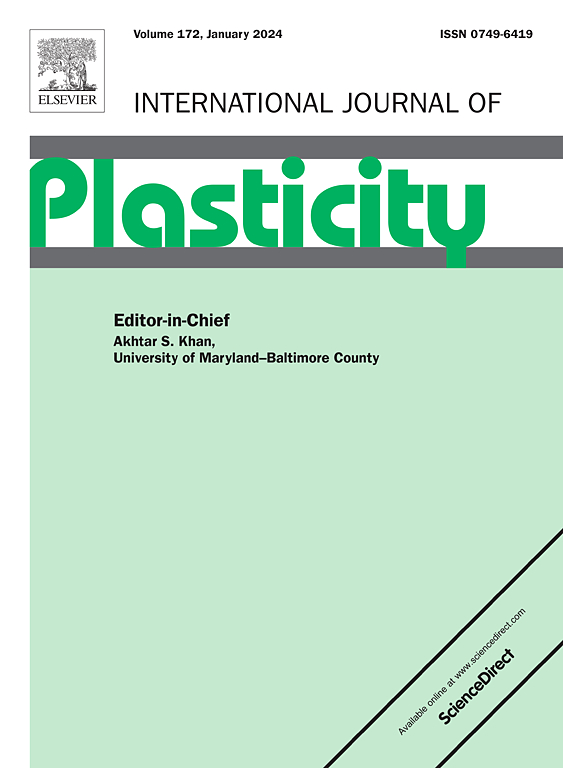Simulation of fracture behaviors in hydrogenated zirconium alloys using a crystal plasticity coupled phase-field fracture model
IF 9.4
1区 材料科学
Q1 ENGINEERING, MECHANICAL
引用次数: 0
Abstract
Zirconium (Zr) alloys are widely used as fuel cladding materials in nuclear reactors; however, the formation of hydride precipitates within these alloys during service significantly reduces their ductility. The effects of hydrides on the fracture behavior of Zr alloys, particularly the role of misfit strain induced by hydride precipitation, remains inadequately understood. Additionally, there is a lack of robust mesoscale models to accurately describe the failure mechanisms of hydrogenated Zr alloys. In response, we develop a crystal plasticity coupled phase-field fracture model that accounts for the evolution of dislocation density, the degradation of critical energy release rate, and the coupling effects between plasticity and damage. The model is employed to investigate the effects of misfit strain induced by hydride precipitation, hydride orientation, and hydride volume fraction on the fracture behavior of hydrogenated Zr alloys. The study also explores the underlying microscopic fracture mechanisms in detail. The results demonstrate that the proposed model effectively captures the influences of hydrides on the ductility of Zr alloys. Specifically, an increase in hydride volume fraction leads to a significant reduction in the ductility and toughness of Zr alloys. The microscopic fracture characteristics of hydrogenated Zr alloys differ significantly between those containing circumferential and radial hydrides, resulting in substantially lower ductility and toughness in samples with radial hydrides under the same conditions. Most importantly, our simulations reveal that misfit strain induced by hydride precipitation is an indispensable factor leading to hydrogen embrittlement in Zr alloys. This research provides valuable insights into the failure mechanisms of hydrogenated Zr alloys and offers a powerful tool for accurately modeling their fracture behavior.


用晶体塑性耦合相场断裂模型模拟氢化锆合金断裂行为
锆(Zr)合金在核反应堆中广泛用作燃料包壳材料;然而,这些合金在使用过程中形成的氢化物沉淀会大大降低其延展性。氢化物对Zr合金断裂行为的影响,特别是由氢化物析出引起的失配应变的作用,仍然没有得到充分的了解。此外,缺乏可靠的中尺度模型来准确描述氢化Zr合金的失效机制。为此,我们建立了晶体塑性耦合相场断裂模型,该模型考虑了位错密度的演化、临界能量释放率的退化以及塑性与损伤之间的耦合效应。采用该模型研究了氢化物析出引起的失配应变、氢化物取向和氢化物体积分数对氢化Zr合金断裂行为的影响。该研究还详细探讨了潜在的微观断裂机制。结果表明,该模型有效地反映了氢化物对Zr合金塑性的影响。具体来说,氢化物体积分数的增加导致Zr合金的延展性和韧性显著降低。氢化Zr合金的微观断裂特征与含有径向氢化物的合金有显著差异,导致在相同条件下含有径向氢化物的合金的塑性和韧性明显降低。最重要的是,我们的模拟表明,氢化物析出引起的失配应变是导致Zr合金氢脆的不可缺少的因素。该研究为氢化Zr合金的失效机制提供了有价值的见解,并为准确模拟其断裂行为提供了有力的工具。
本文章由计算机程序翻译,如有差异,请以英文原文为准。
求助全文
约1分钟内获得全文
求助全文
来源期刊

International Journal of Plasticity
工程技术-材料科学:综合
CiteScore
15.30
自引率
26.50%
发文量
256
审稿时长
46 days
期刊介绍:
International Journal of Plasticity aims to present original research encompassing all facets of plastic deformation, damage, and fracture behavior in both isotropic and anisotropic solids. This includes exploring the thermodynamics of plasticity and fracture, continuum theory, and macroscopic as well as microscopic phenomena.
Topics of interest span the plastic behavior of single crystals and polycrystalline metals, ceramics, rocks, soils, composites, nanocrystalline and microelectronics materials, shape memory alloys, ferroelectric ceramics, thin films, and polymers. Additionally, the journal covers plasticity aspects of failure and fracture mechanics. Contributions involving significant experimental, numerical, or theoretical advancements that enhance the understanding of the plastic behavior of solids are particularly valued. Papers addressing the modeling of finite nonlinear elastic deformation, bearing similarities to the modeling of plastic deformation, are also welcomed.
 求助内容:
求助内容: 应助结果提醒方式:
应助结果提醒方式:


